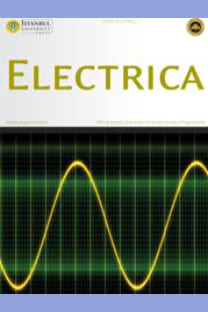SOLVING SUDOKU PUZZLE with NUMBERS RECOGNIZED by USING ARTIFICIAL NEURAL NETWORKS
SOLVING SUDOKU PUZZLE with NUMBERS RECOGNIZED by USING ARTIFICIAL NEURAL NETWORKS
SUDOKU, Puzzle Solving Artificial Neural Networks, Image Recognition, Training,
___
- [1] M. Simkova, “Using of Computer Games in Supporting Education”, Procedia - Social and Behavioral Sciences, 141, pp.1224-1227, 2014.
- [2] Y.G. Butler, “The use of computer games as foreign language learning tasks for digital natives”, System, 54,pp.91- 102, 2015.
- [3] G.G. Smith, M. Li, J. Drobisz, H.R. Park, D. Kim, and S.D. Smith, “Play games or study? Computer games in eBooks to learn English vocabulary”, Computers and Education, 69, pp.274-286, 2013.
- [4] N. Alias, F. Rosman, M.N.A. Rahman and D. Dewitt, “The Potential of Video Game in Malay Language Learning for Foreign Students in a Public Higher Education Institution”, Procedia - Social and Behavioral Sciences, 176, pp.1020-1027, 2015.
- [5] I. Ahmad and A. Jaafar, “Computer Games: Implementation into Teaching and Learning”, Procedia - Social and Behavioral Sciences, 59, pp.515-519, 2012.
- [6] H.D. Mo and R.G. Xu, “Sudoku Square - a New Design in Field”, Acta Agronomica Sinica, 34(9), pp.1489-1493, 2008.
- [7] R. Kampf and E. Cuhadar, “Do computer games enhance learning about conflicts? A cross-national inquiry into proximate and distant scenarios in Global Conflicts”, Computers in Human Behavior, 52(C), pp.541-549, 2015.
- [8] H. Mahmoudi, M. Koushafar, J.A. Saribagloo, and G. Pashavi, “The Efect of Computer Games on Speed, Attention and Consistency of Learning Mathematics among Students”, Procedia - Social and Behavioral Sciences, 76, pp.419-424, 2015.
- [9] M. Bakker, M. Heuvel-Panhuizen and A. Robitzsch, “Effects of playing mathematics computer games on primary school students multiplicative reasoning ability”, Contemporary Educational Psychology, 40, pp.55-71, 2015.
- [10] F. Ke, “Computer-game- based tutoring of mathematics”, Computers and Education, 60(1), pp.448-457, 2013.
- [11] F. Ke, “An implementation of design-based learning through creating educational computer games: A case study on mathematics learning during design and computing”, Computers and Education, 73, pp.26-39, 2014.
- [12] J. Cooper and A. Kirkpatrick, “Critical sets for Sudoku and general graph colorings”, Discrete Mathematics, 315-316, pp.112-119, 2014.
- [13] S.K. Jones, S. Perkins and P.A. Roach, “Properties, isomorphismsand enumeration of 2-Quasi- Magic Sudoku grids”, Discrete Mathematics, 311(13), pp.1098-1110, 2011.
- [14] R. Soto, B. Crawford, C. Galleguillos, E. Monfroy and F. Paredes, “A hybrid AC3-tabu search algorithm for solving Sudoku puzzles”, Expert Systems with Applications, 40(15), pp.5817-5821, 2013.
- [15] A.K. Maji, S. Jana and R.K. Pal, “An Algorithm for Generating only Desired Permutations for Solving Sudoku Puzzle”, Procedia Technology, 10, pp.392-399, 2013.
- [16] D. Dor and U. Zwick, “SOKOBAN and other motion planning problems. Computational Geometry, 13(4), pp.215-228, 1999.
- [17] R.A. Hearn and E.D. Demaine, “PSPACE-completeness of sliding-block puzzles and other problems through the nondeterministic constraintlogic model of computation”, Theoretical Computer Science, 343(1-2), pp.72-96, 2005.
- [18] T. Anthony, D. Polani and C.L. Nehaniv, “General Self-Motivation and Strategy Identification: Case Studies Based on Sokoban and Pac-Man”, IEEE Transactions on Computational Intelligence and AI in Games, 6(1), pp.1-17, 2014.
- [19] M. Mahdian and E.S. Mahmoodian, “Sudoku Rectangle Completion”, Electronic Notes in Discrete Mathematics, 49, pp.747-755, 2015.
- [20] R. Bejar, C. Fernandez, C. Mateu and M. Valls, “The Sudoku completion problem with rectangular hole pattern is NP-complete”, Discrete Mathematics, 312, pp.3306-3315, 2012.
- [21] G. Santos-Garcia and M. Palomino, “Solving Sudoku Puzzles with Rewriting Rules”, Electronic Notes in Theoretical Computer Science, 176, pp.79-93, 2007.
- [22] K. Levenberg, “A method for the solution of certain problems in least squares”, Quarterly of Applied Mathematics, 5, pp.164-168, 1944.
- [23] D. Marquardt, “An algorithm for least-squares estimation of nonlinear parameters”, SIAM Journal on Applied Mathematics, 11, pp.431-441, 1963.
- [24] S. Haykin, “Neural Networks and Learning Machines” (3rd ed.). Prentice Hall.
- [25] S. Sevgen, E. Arslan and R. Samli, “Number Recognition of Sudoku Grid Image with Artificial Neural Networks”, In Proceedings of 22nd International Conference on Neural Information Processing (ICONIP 2015), pp.540-547, 2015.
- ISSN: 2619-9831
- Yayın Aralığı: 3
- Başlangıç: 2001
- Yayıncı: İstanbul Üniversitesi-Cerrahpaşa
Faruk AKTAŞ, Emre KAVUŞ, Yunus Kavuş
Evaluation of Stress Parameters Based on Heart Rate Variability Measurements
FUZZY PID CONTROLLER FOR PROPELLER PENDULUM
Microcontroller Based Wye-Delta Starter and Protection Relay for Cage Rotor Induction Motor
Mehmet Onur GULBAHCE, Derya Ahmet KOCABAS, Aysel ERSOY YILMAZ
Murat Erhan BALCI, Mehmet Hakan HOCAOGLU
Deger Ayata, Yusuf Yaslan, Mustafa Kamaşak
Assessment of Similarity Rates of Liver Images Using Geometric Transformations
Tuğba PALABAŞ TAPKIN, Onur OSMAN, Tuncer ERGİN, Uygar TEOMETE, Özgür DANDİN, Nizamettin AYDIN
Ayşegül GÜVEN, Serhat Aladağ, Nazan Dolu, Hatice Özbek
Çiğdem Gülüzar Altıntop, Fatma Latifoğlu, Emre Çelikzencir, Gülten Can Sezgin, Mustafa Alper Yurci
